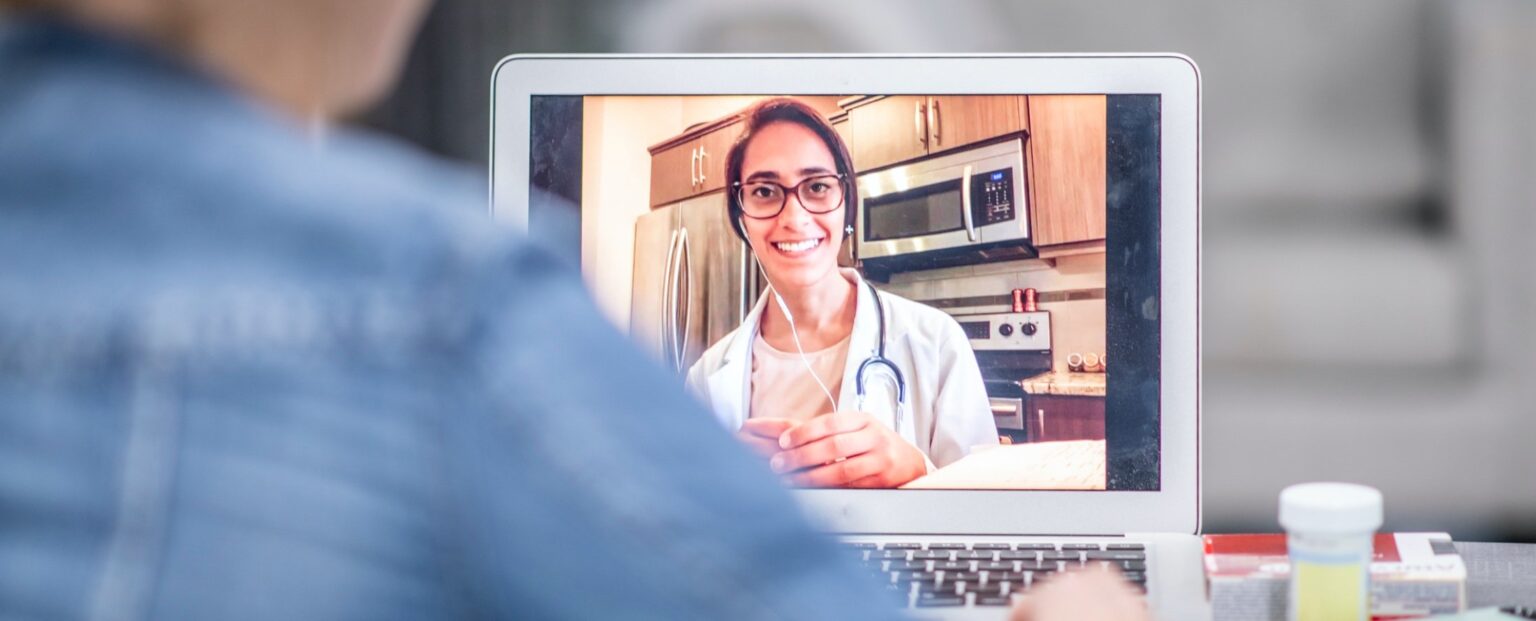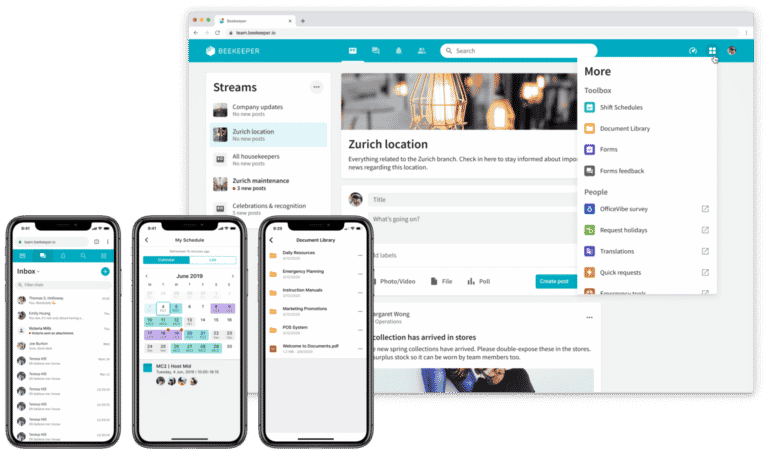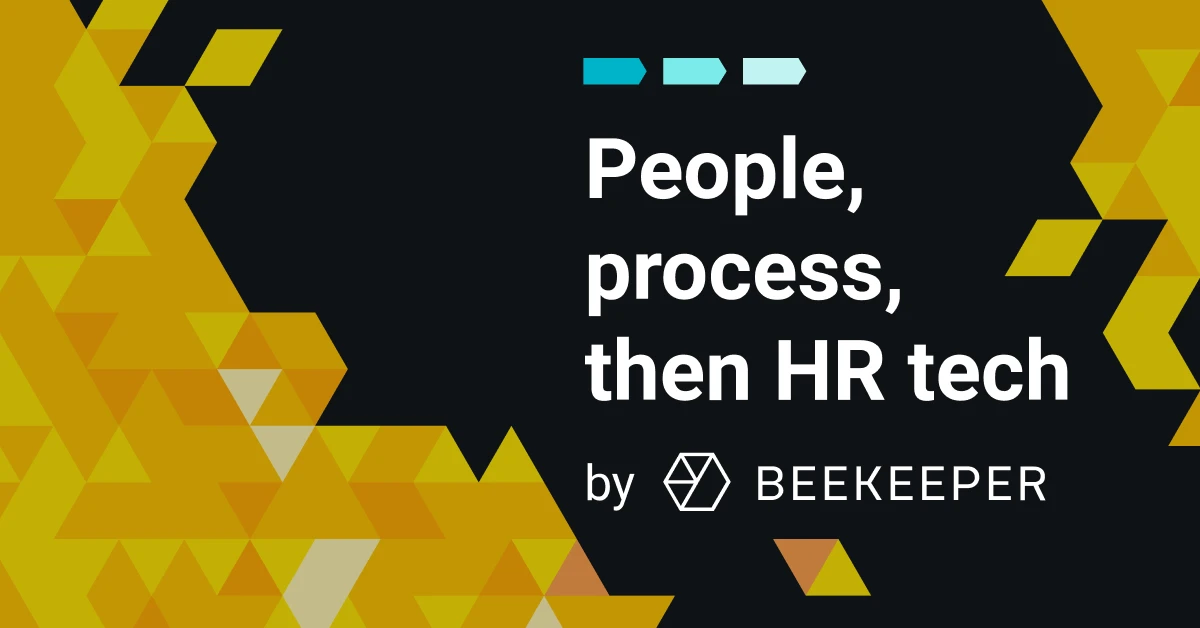Top Healthcare Trends | Accelerating The Industry’s Digital Transformation

Table of contents
- What Is Healthcare Technology?
- 1. Digital Transformation: The Focal Point of 2021 Healthcare Industry Trends
- 2. Remote Healthcare Technology Means Telehealth Is Here to Stay
- 3. Data Accessibility and Privacy Is Paramount In Healthcare Technology
- 4. Accelerated Adoption in Mobile Communication Apps For On-The-Go Information
- 5. Acting on Lessons Learned in Crisis Management
There’s no question that the COVID-19 global pandemic turned the healthcare industry on its head in 2020.
In fact, the industry is still on the road to recovery at the time of this post. It continues to tackle high global infection rates, over-capacity facilities, and now, vaccination rollouts.
But 2021 is a new day.
Like many others, the healthcare industry is evolving from the crisis and looking forward to what’s next. As a result, 2021 healthcare industry trends, such as the digital transformation and advancements in healthcare technology, are changing the industry from the ground up.
Let’s look at some of the healthcare trends driving the digital revolution of the industry in 2021.
What Is Healthcare Technology?
Before the global pandemic, the healthcare industry lagged when it came to digital technology adoption.
According to the World Health Organization (WHO), health technology is defined as:
The application of organized knowledge and skills in the form of devices, medicines, vaccines, procedures, and systems developed to solve a health problem and improve quality of lives.”
McKinsey’s research indicated the main barrier to broader healthcare technology adoption wasn’t the technology itself. It was culture.
Yet, given the rise in the usage of digital tools, it was only a matter of time before healthcare embraced this trend of digitization. Now, from administration to mental health to diagnostics, advancements in healthcare technology is impacting every sector of the healthcare industry.
Rise of The Smart Hospital
One of the main drivers of the healthcare technology revolution is the growth of smart hospitals.
According to Philips,
A ‘Smart Hospital’ relies on optimized and automated processes, built on an ICT environment of interconnected assets (the Internet of Things (IoT)) aimed at improving existing patient care procedures and introducing new capabilities. It relies on the big data revolution – the ‘Fourth Industrial Revolution’ – which combines connected devices with cloud computing, big data analytics, and artificial intelligence (AI) – to ensure that the critical infrastructure is ‘smart.’”
Similar to Industry 4.0, smart hospital technology requires more flexible and connected workforces. Everything in the hospital needs to communicate with one another – from employees to machines as well as employees to other employees.
The technology used in smart hospitals includes:
- Digital connectivity
- Automation
- Patient-first experiences
- Big data
- Mobile communication solutions
With that in mind, here are our top five healthcare trends coming in 2021.
1. Digital Transformation: The Focal Point of 2021 Healthcare Industry Trends
The digital transformation in the healthcare industry is long overdue. Given the global pandemic of 2020, hospitals worldwide were stretched to their limit – in capacity, supplies, frontline workers, and technological capabilities.
This is why one of the top healthcare industry trends of 2021 will be doubling down on digital transformation.

At Beekeeper, we’ve identified four steps companies must take to create a digitally enabled workplace of the future:
- Adopt a digital channel to reach and connect the entire frontline workforce
- Digitize time-consuming, inefficient, and expensive paper-based processes
- Establish an automation strategy that harnesses the full knowledge and power of frontline employees
- Optimize organizational processes with data-driven insights
Equipping frontline workers with the digital tools they need to stay flexible is essential to a successful digital transformation.
The modern worker has both a need and a right to access a range of material on-demand and on a device of their choosing. This is especially true when it comes to frontline workers, whose success is contingent on their ability to use the right tool at the right time.
Digital workplaces are taking off in every industry, and they aren’t just for office-based employees. The benefits of a digitally connected frontline workforce include:
- Creating a happier and more productive work environment
- Attracting and retaining more skilled talent
- Reaching more meaningful employee satisfaction
Pro Tip: Frontline workers – like nurses, doctors, and office assistants – are the heart and soul of the healthcare industry. Stay ahead of their needs by getting a refresher on who are frontline workers, what they need, and what the future of work looks like for them.
In the healthcare industry, IT healthcare trends are pointing towards a more digitally enabled future. Facilities are re-energizing efforts to adopt smart hospital technologies to:
- Handle increasing patient demand
- Cut operational costs
- Enhance workplace productivity
- Reduce waste
- Provide more flexible solutions to frontline workers and patients alike
For example, the adoption of self check-in kiosks at hospitals is expected to speed up wait times and cut down manual paper processes.
Additionally, the days of trying to understand hard-to-read handwriting are coming to an end. Electronic medical records provide easy, on-the-go access to patient information where and when medical staff needs it.
2. Remote Healthcare Technology Means Telehealth Is Here to Stay
Virtual doctor visits are a healthcare technology trend that is expected to stick around for the long-term. In fact, Deloitte estimates virtual video visits to doctors will rise to 5% globally in 2021. That’s 8.5 billion doctor’s visits.
But let’s backtrack quickly. Because of COVID-19, doctor’s offices worldwide had to pivot their method of patient care quickly. Many turned to telehealth solutions to reach patients in the comfort of their own homes.
Telehealth is the use of digital technology, such as video calling through computers and mobile devices, to provide health care to remote or long distanced patients.
ccording to PwC’s Health Research Institute (HRI)’s recent survey:
- 92% of healthcare provider leaders are using telehealth for primary care services
- 68% indicate telehealth is most useful for follow-up appointments
So, where does telehealth go from here?
According to McKinsey, there is a staggering $250 billion opportunity for virtualized health care in the U.S.
The industry does not expect to maintain the same level of telehealth rates as experienced during the pandemic. But, it has opened the door to a new way of accessing health care.
Facilities are now looking to enhance their technological infrastructure and continue offering telecare solutions beyond the COVID recovery.
3. Data Accessibility and Privacy Is Paramount In Healthcare Technology
One of the biggest hurdles to the long-term use of telehealth capabilities is ensuring patient information and data security.
The rise of COVID-19 and virtual healthcare appointments also meant an increase in cybersecurity threats. According to the HIPAA Journal, there were 25% more healthcare-related data breaches in 2020 than in 2019. Further, 560 healthcare facilities experienced ransomware attacks last year.
Those breaches not only undermine the integrity of patient information security – but they are costly. An IBM study found that healthcare companies incurred an average breach cost of $7.13 million — an over 10% increase compared to the 2019 study.
In 2021, health care providers will do what they can to achieve cyber resilience. According to the Herjavec Group, cybersecurity spending in the healthcare industry is expected to rise to $125 billion between 2020-2025.
This year, healthcare facilities will take next-level security steps by focusing on these key areas:
- Activating more security for remote workers – often seen as in easy in for attackers
- Issuing more extensive identity and access controls
- Providing relevant, actionable cybersecurity training
- Utilizing automation where able
Healthcare facilities will remain vigilant in protecting their patients’ information.
4. Accelerated Adoption in Mobile Communication Apps For On-The-Go Information

If 2020 taught us anything, it’s that now is the time for consistent, mobile-first communication channels.
No matter if your healthcare employees are in the ER or the diagnostics lab, the quickest way to reach them with essential company information is through their mobile devices.
In fact, 96% of Americans own a smartphone, with 22% of younger adults relying solely on smartphones to access the internet. That means mobile is now mission-critical.
In 2021, mobile communication apps for healthcare workers are more important than ever. Benefits of providing an employee communication app for healthcare workers include:
- Having a more engaged workforce providing better patient care
- Saving more lives with instant, easy-to-access patient information
- Ensuring continuity of care with better team communications
- Accessing real-time information when and where it is needed
When considering mobile communication apps for your frontline healthcare workers, make sure your toolkit includes these key features:
- Instant access to important company information
- Digital document library with digitized workplace materials, guidelines, shift schedules, and training information
- Strict regulatory compliance and data protection measures
- Open feedback tools, like surveys, to gather input directly from frontline employees
- Seamless integrations with other essential healthcare platforms
- 1:1 and group chat functions to reach other team members directly
Already know you need to make a communication change but don’t know where to start? Here are five ways to improve communication in healthcare:
- Assess your current communication channels and understand significant gaps in communication access
- Ensure communication channels are streamlined
- Make it mobile for those essential employees that are always on their feet
- Promote open feedback channels
- Make time for (safe) in-person communication
5. Acting on Lessons Learned in Crisis Management and Business Continuity
The healthcare industry wants to build back better in 2021. The first step is learning from the many lessons 2020 brought us.
One of those essential lessons is: How can we do better in the next crisis?
Businesses will address this in two ways:
- Adopting new technologies that make operations more agile in a quickly changing environment
- Developing comprehensive crisis management and business continuity plans
A business continuity plan is a set of protocols, procedures, and policies that enables an organization to preserve and protect essential operations in the face of disasters, emergencies, or threats.
The building blocks of a business continuity plan include:
- Determine the plan’s purpose: Define success for your plan. Then, build a roadmap that helps you get there.
- Conduct a business impact analysis: Identify possible threats, areas of vulnerability, and actions you can take to protect your business in a crisis scenario.
- Select the right team: Assign leads of areas that are essential to activating the business continuity plan. Those areas can include facilities, human resources, communications, information technology, and finance.
- Create a strategy for every phase of crises: Include detailed plans for the three major milestones of any crisis situation – prevention, response, and recovery.
During crisis management, communication is vital. So, it’s important to have your business continuity software tools at the ready at all times.
A Deloitte study found 41% of surveyed board members said communication protocols were part of their crisis management regimes. 32% said their companies engage in crisis simulations or training.
According to the Business Continuity Institute, successful business continuity plans:
- Prioritize communications with all team members
- Are activated within one hour of the event
- Prepare ahead of time with training and real-life exercises
With mobile employee communication apps, like Beekeeper, companies can get the right message out to the right people at the right time. Businesses are also able to swiftly reach frontline employees with crisis management information they need in order to:
- Stay safe and healthy
- Take the appropriate course of action as detailed in the business continuity plan
- Instill confidence to customers and patients they continue to work with
Want more insight into the future of work for frontline employees? Fill out the form below to download our Frontline Trends Report.

About the author
Beekeeper
We make frontline lives easier, work safer, and teams more connected so businesses can reach new heights. At Beekeeper, we’re dedicated to making frontline lives easier by connecting workers with the tools, support, and information they need to feel valued, do their best work, and drive the business forward.






